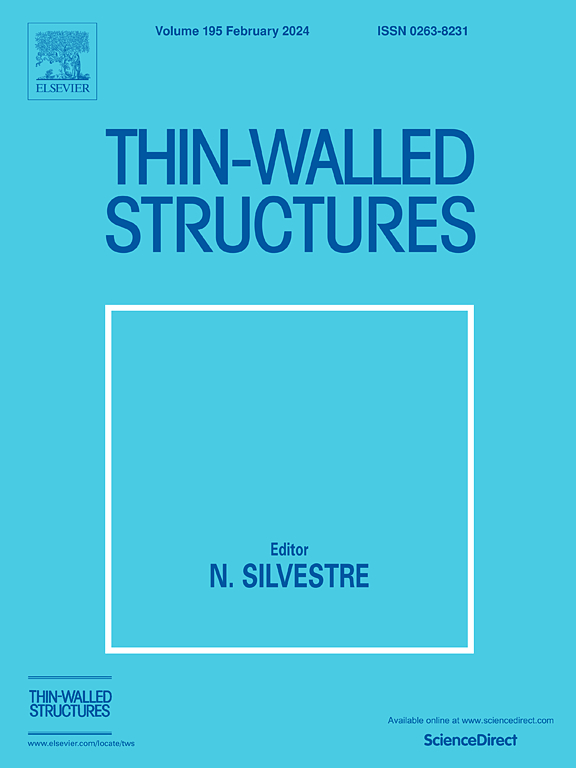Isogeometric flutter analysis of a heated laminated plate with and without cutout
IF 5.7
1区 工程技术
Q1 ENGINEERING, CIVIL
引用次数: 0
Abstract
Understanding the flutter characteristics of heated laminated plates, both with and without cutout, is crucial. This study presents the first exploration of flutter analysis in a thermal environment for a laminated plate featuring a cutout. To facilitate this study, the motion equations of the heated laminated plate with a cutout are derived using the first-order shear deformation theory (FSDT), incorporating a nonlinear term. Employing the isogeometric method combined with multi-path coupling technology, we establish accurate geometric and solution domains for the laminated plate. The effects of the thermal stresses and the aerodynamics calculated by the linear piston theory are considered. The accuracy and effectiveness of the proposed model are validated through several comparisons with ANSYS results and existing solutions. Additionally, the study examines the impact of key parameters on flutter characteristics, including thermal conditions, number of layers, lay-up angles, inflow angles, and cutout dimensions. The insights gained from this research will serve as a valuable benchmark for future analyses and design concerning flutter characteristics.
有切口和无切口加热层压板的等距扑动分析
了解受热层压板(包括有切口和无切口)的飘动特性至关重要。本研究首次探讨了在热环境中对带有切口的层压板进行扑动分析的问题。为便于研究,本研究使用一阶剪切变形理论(FSDT)推导出了带有切口的加热层压板的运动方程,其中包含一个非线性项。利用等距测量法和多路径耦合技术,我们为层压板建立了精确的几何域和求解域。考虑了热应力和线性活塞理论计算的空气动力学的影响。通过与 ANSYS 结果和现有解决方案的多次比较,验证了所提模型的准确性和有效性。此外,研究还考察了关键参数对扑翼特性的影响,包括热条件、层数、铺层角、流入角和切口尺寸。从这项研究中获得的见解将成为未来分析和设计飘动特性的宝贵基准。
本文章由计算机程序翻译,如有差异,请以英文原文为准。
求助全文
约1分钟内获得全文
求助全文
来源期刊

Thin-Walled Structures
工程技术-工程:土木
CiteScore
9.60
自引率
20.30%
发文量
801
审稿时长
66 days
期刊介绍:
Thin-walled structures comprises an important and growing proportion of engineering construction with areas of application becoming increasingly diverse, ranging from aircraft, bridges, ships and oil rigs to storage vessels, industrial buildings and warehouses.
Many factors, including cost and weight economy, new materials and processes and the growth of powerful methods of analysis have contributed to this growth, and led to the need for a journal which concentrates specifically on structures in which problems arise due to the thinness of the walls. This field includes cold– formed sections, plate and shell structures, reinforced plastics structures and aluminium structures, and is of importance in many branches of engineering.
The primary criterion for consideration of papers in Thin–Walled Structures is that they must be concerned with thin–walled structures or the basic problems inherent in thin–walled structures. Provided this criterion is satisfied no restriction is placed on the type of construction, material or field of application. Papers on theory, experiment, design, etc., are published and it is expected that many papers will contain aspects of all three.
 求助内容:
求助内容: 应助结果提醒方式:
应助结果提醒方式:


